Читать книгу Manual of American Grape-Growing - U. P. Hedrick - Страница 102
На сайте Литреса книга снята с продажи.
Catch-crops.
ОглавлениеCatch-crops are not, as a rule, profitable in commercial vineyards; they may bring temporary profit but in the long run they are usually detrimental to the vines. It may pay and the grape may not be injured in some localities, if such truck crops as potatoes, beans, tomatoes and cabbage are grown between the rows or even in the rows for the first year and possibly the second. Land, to do duty by the two crops, however, must be excellent and the care of both crops must be of the best. Growing gooseberries, currants, any of the brambles, or even strawberries, is a poor procedure unless the vineyard is small, the land very valuable or other conditions prevail which make intensive culture possible or necessary. The objections to catch-crops in the vineyard are two: they rob the vines of food and moisture and endanger them to injury from tools in caring for the catch-crop.
Sometimes the grape itself is planted as a catch-crop in the vineyard. That is, twice the number of vines required in a row for the permanent vineyard are set with the expectation of cutting out alternate vines when two or three crops have been harvested and the vines begin to crowd. This practice is preferable to inter-planting with bush-fruits, yet there is not much to commend it if the experience of those who have tried it is taken as a guide. Too often the filler vines are left a year too long with the result that the permanent vines are checked in growth for several years following. The profits from the fillers are never large, scarcely pay for the extra work, and if the permanent vines are stunted, the filler must be put down as a liability rather than as an asset.
